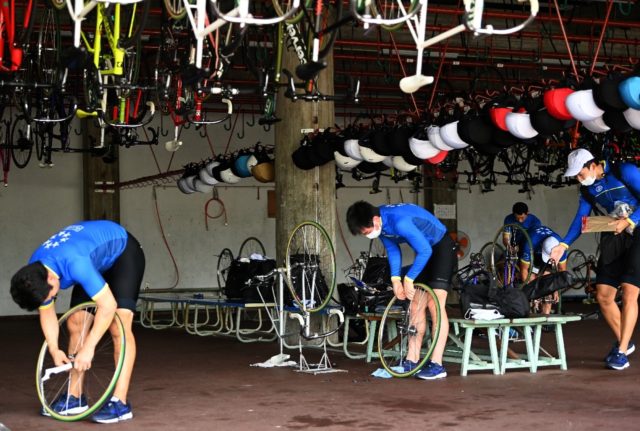They reveal their tactics before the race, wear armour to protect themselves from attacks and give presents to the opponents they beat.
That does not happen in the keirin at the Olympics, inside the shiny Izu Velodrome, but in the keirin Japan invented more than 70 years ago.
It is preserved through an exclusive, militant training school and laments its grubby image linked to gambling, corruption and violence.
A national obsession in Japan, keirin is a discipline also cherished for its simplicity, with riders lurking behind a pacemaker, before launching into a three-lap sprint to the finish.
But while keirin has featured in the Olympics track programme for two decades, Japan’s domestic version is a far cry from the one rolled out every four years in pursuit of gold medals.
“Keirin has this very ambiguous place in the Japanese consciousness,” says Justin McCurry, author of “War on Wheels, Inside the Keirin and Japan’s Cycling”.
Japan’s best keirin riders rarely even show up for the Games.
On the domestic circuit, stars can earn more than a million dollars a year, with the end-of-season Grand Prix handing out 100 million yen to the winner.
“When you’re Japanese and you earn one or two million euros a year, you have no interest in wasting your time on international races which just lose them money,” Japan’s French keirin coach Benoit Vetu tells AFP.
It is a key reason why Japan has only ever won one Olympic keirin medal, and never a gold.
“We have pride in the keirin but at the same time it’s a huge challenge for us,” says Japanese cycling journalist Junki Iwasawa.
Keirin’s ‘grittier edge’
Despite the larger financial rewards, Japanese keirin also has a grittier edge.
To counter problems with race-fixing, each bike is assembled by its rider and checked to ensure nobody starts with an advantage.
Every bike is the same, not crafted by aerodynamicists like the Olympic models, but old, steel ones, practically unchanged in 50 years.
“Keirin now bends over backwards to ensure it’s a clean sport and largely it is, but it’s so deeply connected to this sub-culture in Japanese society,” says McCurry.
“It’s a culture Japan doesn’t want the rest of the world to see.”
Races can be brutal -– head-butting, shoulder-barging and crashes are common –- but there is also respect.
At the end, winners offer water to their vanquished opponents or give presents, like their tyres or gloves.
Values of honesty and self-control are honed at the Japanese Institute of Keirin, the official school near Izu, where 70 students are selected each year from almost 400 applicants and put through a gruelling 10-month training regime.
There are physical sessions but just as important are academic classes in tactics, law and mechanics. “It’s an army of cyclists,” says Vetou.
Rules are strict but with more than 4,000 professional keirin riders in Japan, the prospects for graduates are good.
Yukoh Saito, a 26-year-old from Tokyo, went to the United States to be a baseball player. When he fell short, he returned to Japan and turned his attention to keirin.
“To be a professional athlete is my lifelong dream, that is my main motivation, but also financially keirin is very good, you can make a million dollars if you are good at it,” says Saito.
“I can’t go to bars or hang out with my friends but I can do what I love. And hopefully in the future it will be worth it.”
Riders reveal tactics
The financial rewards stem from the betting receipts of predominantly older, retired men, who watch in betting bars while run-down velodromes where the races actually happen stay empty.
Riders even have to reveal their tactics before races to help punters decide who to back.
Since the first velodrome was built in 1948, an estimated 360 billon dollars has been spent on betting on keirin.
It means gambling has not only come to define the sport in Japan but it is seen as the continuation of a darker side that always existed.
“In the old days you had race fixing and organised crime and gangs all very involved with keirin. There were drunken brawls and violence,” says McCurry. “Local leaders even wanted velodromes to close because people thought they were a terrible influence on children.”
There is a contradiction too, that the male dominated betting industry that makes keirin so lucrative in Japan is also what prevents it from having a wider, international appeal.
A Japanese medal might be celebrated as a symbol of kinship between the keirin of the Olympics and the keirin of old. But for many, there would be hope it could be the start of something new.

COMMENTS
Please let us know if you're having issues with commenting.